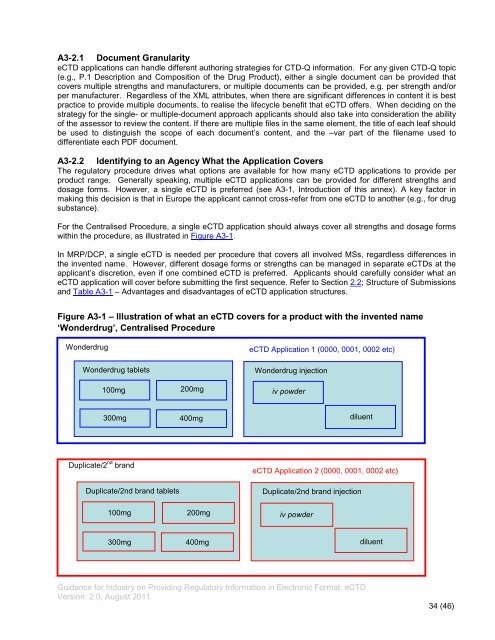eCTD Guidance Document - eSubmission - Europa
eCTD Guidance Document - eSubmission - Europa
eCTD Guidance Document - eSubmission - Europa
Create successful ePaper yourself
Turn your PDF publications into a flip-book with our unique Google optimized e-Paper software.
A3-2.1 <strong>Document</strong> Granularity<br />
<strong>eCTD</strong> applications can handle different authoring strategies for CTD-Q information. For any given CTD-Q topic<br />
(e.g., P.1 Description and Composition of the Drug Product), either a single document can be provided that<br />
covers multiple strengths and manufacturers, or multiple documents can be provided, e.g. per strength and/or<br />
per manufacturer. Regardless of the XML attributes, when there are significant differences in content it is best<br />
practice to provide multiple documents, to realise the lifecycle benefit that <strong>eCTD</strong> offers. When deciding on the<br />
strategy for the single- or multiple-document approach applicants should also take into consideration the ability<br />
of the assessor to review the content. If there are multiple files in the same element, the title of each leaf should<br />
be used to distinguish the scope of each document’s content, and the –var part of the filename used to<br />
differentiate each PDF document.<br />
A3-2.2 Identifying to an Agency What the Application Covers<br />
The regulatory procedure drives what options are available for how many <strong>eCTD</strong> applications to provide per<br />
product range. Generally speaking, multiple <strong>eCTD</strong> applications can be provided for different strengths and<br />
dosage forms. However, a single <strong>eCTD</strong> is preferred (see A3-1, Introduction of this annex). A key factor in<br />
making this decision is that in Europe the applicant cannot cross-refer from one <strong>eCTD</strong> to another (e.g., for drug<br />
substance).<br />
For the Centralised Procedure, a single <strong>eCTD</strong> application should always cover all strengths and dosage forms<br />
within the procedure, as illustrated in Figure A3-1.<br />
In MRP/DCP, a single <strong>eCTD</strong> is needed per procedure that covers all involved MSs, regardless differences in<br />
the invented name. However, different dosage forms or strengths can be managed in separate <strong>eCTD</strong>s at the<br />
applicant’s discretion, even if one combined <strong>eCTD</strong> is preferred. Applicants should carefully consider what an<br />
<strong>eCTD</strong> application will cover before submitting the first sequence. Refer to Section 2.2; Structure of Submissions<br />
and Table A3-1 – Advantages and disadvantages of <strong>eCTD</strong> application structures.<br />
Figure A3-1 – Illustration of what an <strong>eCTD</strong> covers for a product with the invented name<br />
‘Wonderdrug’, Centralised Procedure<br />
Wonderdrug<br />
Wonderdrug tablets<br />
100mg<br />
300mg<br />
Duplicate/2 nd brand<br />
Duplicate/2nd brand tablets<br />
100mg<br />
200mg<br />
400mg<br />
200mg<br />
<strong>eCTD</strong> Application 1 (0000, 0001, 0002 etc)<br />
Wonderdrug injection<br />
iv powder<br />
diluent<br />
<strong>eCTD</strong> Application 2 (0000, 0001, 0002 etc)<br />
Duplicate/2nd brand injection<br />
iv powder<br />
300mg 400mg<br />
diluent<br />
<strong>Guidance</strong> for Industry on Providing Regulatory Information in Electronic Format: <strong>eCTD</strong><br />
Version: 2.0, August 2011<br />
34 (46)


